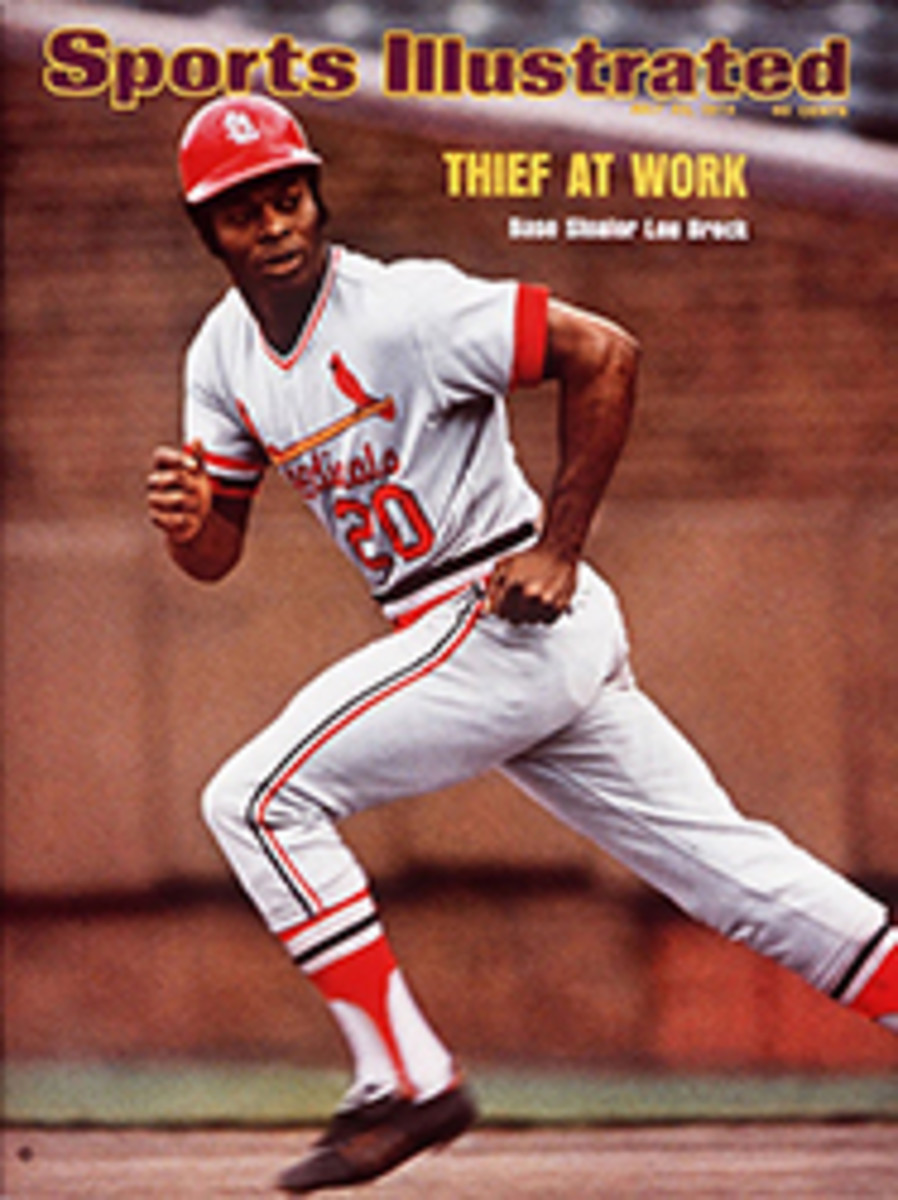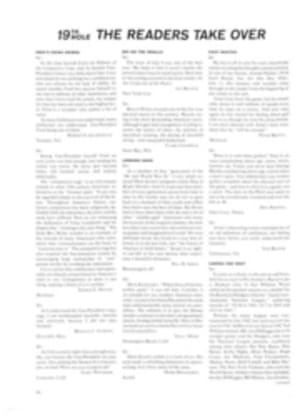
No need to forego picking him
The best thoroughbred running on American racetracks is probably an outsized 4-year-old gelding named Forego. People who follow racing only casually may be surprised to learn that horsemen rate such a relatively unknown animal ahead of the 3-year-old star Little Current, who won the Preakness and Belmont so impressively, but in the opinion of the experts there is not much doubt about it. Forego, king of the handicap division, is just about the best horse going.
The key to the handicap division is weight. In their major races, Little Current and his fellow 3-year-olds toted the same poundage. In the handicap events a top horse like Forego is obliged to carry more weight, sometimes much more, than his rivals. The object of such handicapping is to assign varying weights so that all horses in a field are evenly matched—at least theoretically. A perfect handicap race would end in a massive dead heat.
This concept encourages trainers to enter lightly weighted horses against the formidable Forego, and it stimulates betting, the lifeblood of the sport. Handicapping also makes it difficult for an outstanding horse to perform well consistently, but Forego manages. He has won 10 of his last 14 starts, and was second three times and third once. During one imposing stretch he won six straight handicaps. When he lost by two lengths to a 60-to-1 shot, Arbees Boy, in the Metropolitan mile on Memorial Day, Forego carried 134 pounds to the winner's 112. Kenny Noe, racing secretary and handicapper at New York tracks, follows the rule that says each pound of extra weight costs a horse one length at distances of a mile or over. Noe took two pounds off Forego in his next start, the seven-furlong Nassau County Handicap, but the big horse, now under 132 pounds, failed by half a length to catch another long shot, Timeless Moment, who carried only 112. For the Brooklyn Handicap on July 4, Noe dropped Forego down to 129 pounds; and this time he won by three-quarters of a length over Billy Come Lately, at 114, and was 2¾ lengths ahead of Arbees Boy, who had been upped to 116. For this Saturday's Suburban Handicap, Noe increased Forego's weight again, to 131 pounds.
"What the handicapper is trying to do," Noe says, "is be fair to the horse, the trainer and the owner. I live with these people every day all year long and I like to think, despite their complaining, which you get used to, that they are my friends. You've got to be fair with your friends."
One such friend, trainer Elliott Burch, moaned to Noe before the Nassau County Handicap that the 112 pounds on his horse, Timeless Moment, was too much and that the impost should be no more than 110. When Timeless Moment beat Forego, Noe smiled at the abashed Burch, who said nothing.
"The handicapper must watch his horses closely," says Noe. "I don't go on time as much as I do on looks. I want to see for myself if a horse wins with authority. Is the jock all-out, or is he sitting there all folded up? And you've got to know your trainers and their habits. Some train a horse up to a major race, while others race them into condition. Some horses do better on certain tracks. Some prefer grass to dirt. You add it all up, consider the distance of the race and assign weights on the assumption that the track will be fast. If it comes up slop or mud at the last minute, your figures can look pretty bad."
Noe bases his weight allotments on a horse's current form rather than on what he has done in the past. He says the toughest race he ever handicapped was the first running of the Marlboro Cup last September, in which Secretariat and another 3-year-old, Annihilate 'Em, took on five older horses, all outstanding handicap stars: Riva Ridge, Cougar II, Kennedy Road, Key to the Mint and Onion, who had upset Secretariat at even weights in the Whitney stakes several weeks earlier.
"No one knew for sure if Secretariat was back in top form," says Noe, who decided for himself that the colt was fit and ready. At that time of year a 3-year-old is rated six pounds lighter than an equivalent 4-year-old, on the assumption that at four a horse is bigger, stronger and faster. Yet Noe gave Secretariat 124 pounds to 127 for Riva Ridge, 126 for Cougar II and 126 for Key to the Mint. Others got lesser weights, including Onion at 116. In effect, the 3-year-old Secretariat was the high weight in the race. "As it turned out," Noe says, "he was in top form. He beat the older horses and won the race in world-record time."
That could have been Secretariat's finest performance, even though his stirring victories in the 3-year-old classics (Kentucky Derby, Preakness, Belmont) are more memorable. The Triple Crown events are horse racing's glamour races, without doubt, but the handicap division is extremely popular with racegoers. One reason is that many of its stars are geldings, who seem to last, if not forever, at least long enough to acquire a following of railbirds who regard them as they might a family pet. Secretariat, a stallion, had too much potential value as a sire to race any longer, and he was retired to stud at three, but the gelded Forego will continue to run as long as he is fit and able.
Kelso, the best gelding of all time, raced until he was nine, won 39 of 63 starts, earned $1,977,896 and was named Horse of the Year five times. Haifa century ago Exterminator, a gelding who won the Kentucky Derby in 1918, ended an extraordinary eight-year career in which he won exactly half of his 100 races. Joe Jones, who ran until he was 10, was another great favorite, picking up part of the purse in 106 of his 175 starts, and Armed started 81 times. When Native Dancer was the center of attention in the early 1950s, he had two impressive geldings as stablemates, Find and Social Outcast, who started 168 times between them and won 40 races and $1,470,915. In contrast, the Dancer went to the post only 22 times. Stallions generally have brief competitive careers. Damascus raced only 32 times, Buckpasser 31, Nashua 30. Man o' War and Secretariat had 21 races apiece.
In contrast, too, are the comparative values of, say, a Forego and a Secretariat, who are the same age. Secretariat was syndicated as a stallion for $6,080,000. If Forego were sold now, even assuming continued soundness as a racer for several years, he most likely would not comma≈Ñd one-tenth Secretariat's price—since he has no value at stud.
Male thoroughbreds are gelded primarily because they have not raced or trained well. Some have nasty dispositions; some are so studdish that they can think of nothing but the pretty filly down the shed row; some have soundness problems because they are growing too fast; some, like Kelso, have testicles so large that they interfere with the animal's way of going. Alfred G. Vanderbilt says, "You might say you geld out of despair. It doesn't always improve a horse, but neither will it do his racing ability any harm. Social Outcast won a stakes at two as a colt and was still a colt in 1953 when he ran in both the Wood Memorial and the Derby. But that summer my trainer, Bill Winfrey, thought the horse was cheating a bit—you know, not paying attention, not trying his best—and we gelded him. It obviously worked."
About 85% of today's geldings are altered when they are two years old, although the operation can be performed at any age. MacKenzie Miller, who has been training the 8-year-old Red Reality, says, "This horse was big and he had a soundness problem, so we had him gelded in the fall of his 2-year-old year. We thought it would lighten him up. It did the trick perfectly. He has won more than $550,000." Fort Marcy, who won 21 of 75 races and $1,109,791, was gelded before his first race at the age of two. "We thought he was too feisty," recalls Elliott Burch. "That may have come from his sire, Amerigo, who was a bit on the wild side. The fact is, we don't geld enough horses in this country. If we gelded more, we'd have less unsoundness and far fewer bad sires. Just because a horse is well bred doesn't mean you have to send him to stud."
Forego, who is by the Argentinian champion Forli, is stunningly big and impressive to look at. At 16 hands, 3¾ inches (5'7¾" tall at the withers), he is the largest top horse in training. Dr. Manuel Gilman, the examining veterinarian at New York tracks, says, "They don't come any bigger and run any better. The thing about Forego is that he is perfectly proportioned. He doesn't look so big when you stand off a bit. The size is only apparent when you come up close."
As a 2-year-old Forego was already so big that his ankles kept flaring up. He also had splint trouble. "And he was inclined to be a bit mean," says Sherrill Ward, who trains Forego for Mrs. Martha Gerry, "so I decided to alter him. I never saw an animal respond as well as he did. He is well composed now, but he has retained a lot of fire and fight. You certainly don't want to cross him."
Forego has a lot of company around the racetrack. It is estimated that 60% of the male horses at U.S. tracks are gelded. A recent two-day survey of entries at four tracks showed 272 geldings to 185 entire horses. The figures varied from track to track. At Belmont Park, where many of the leading owner-breeders race, geldings were outnumbered 30 to 67, but at Ohio's River Downs during the same two-day period there were 91 geldings racing and only 20 entire horses.
There are constant arguments about the logic of gelding, which, after all, deprives an outstanding runner like Forego of the chance to make a name for himself at stud. You often hear people say, "Isn't it a pity that horses such as Kelso and Armed and Exterminator were gelded?" Most horsemen, remembering the difficulties such horses had before they were altered, reply, "If they hadn't been gelded, probably nobody would have ever heard of them."
PHOTO
BIG HORSE, BIG WINNER, BIG EATER

